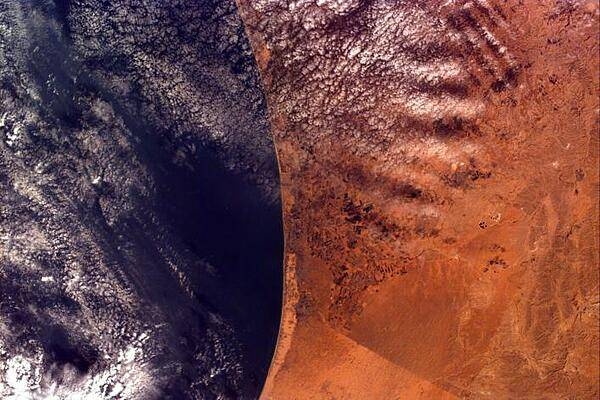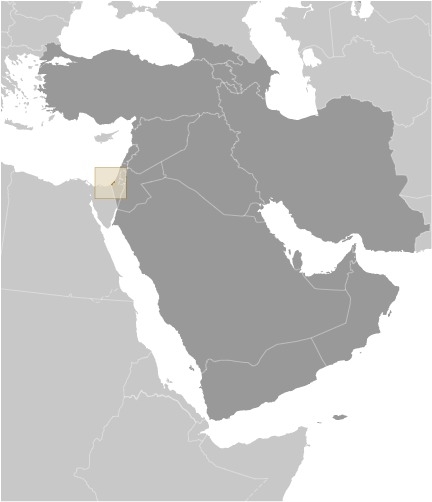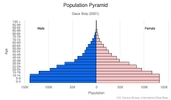Gaza Strip
Introduction
Background
Inhabited since at least the 15th century B.C., the Gaza Strip has been dominated by many different peoples and empires throughout its history; it was incorporated into the Ottoman Empire in the early 16th century. The Gaza Strip fell to British forces during World War I, becoming a part of the British Mandate of Palestine. Following the 1948 Arab-Israeli War, Egypt administered the newly formed Gaza Strip; Israel captured it in the Six-Day War in 1967. Under a series of agreements known as the Oslo accords signed between 1993 and 1999, Israel transferred to the newly-created Palestinian Authority (PA) security and civilian responsibility for many Palestinian-populated areas of the Gaza Strip as well as the West Bank. In 2000, a violent intifada or uprising began, and in 2001 negotiations to determine the permanent status of the West bank and Gaza Strip stalled. Subsequent attempts to re-start negotiations have not resulted in progress toward determining final status of the Israeli-Palestinian conflict.
Israel by late 2005 unilaterally withdrew all of its settlers and soldiers and dismantled its military facilities in the Gaza Strip, but it continues to control the Gaza Strip’s land and maritime borders and airspace. In early 2006, the Islamic Resistance Movement (HAMAS) won a majority in the Palestinian Legislative Council election. Attempts to form a unity government between Fatah, the dominant Palestinian political faction in the West Bank, and HAMAS failed, leading to violent clashes between their respective supporters and HAMAS's violent seizure of all military and governmental institutions in the Gaza Strip in June 2007. Since HAMAS’s takeover, Israel and Egypt have enforced tight restrictions on movement and access of goods and individuals into and out of the territory. Fatah and HAMAS have since reached a series of agreements aimed at restoring political unity between the Gaza Strip and the West Bank but have struggled to enact them; a reconciliation agreement signed in October 2017 remains unimplemented.
In July 2014, HAMAS and other Gaza-based militant groups engaged in a 51-day conflict with Israel culminating in late August with an open-ended truce. Since 2014, Palestinian militants and the Israel Defense Forces have exchanged projectiles and air strikes respectively, sometimes lasting multiple days and resulting in multiple deaths on both sides. Egypt, Qatar, and the UN Special Coordinator for the Middle East Peace Process have negotiated multiple ceasefires to avert a broader conflict. Since March 2018, HAMAS has coordinated weekly demonstrations along the Gaza security fence, many of which have turned violent, resulting in one Israeli soldier death and several Israeli soldier injuries as well as more than 200 Palestinian deaths and thousands of injuries.
Visit the Definitions and Notes page to view a description of each topic.
Geography
Location
Middle East, bordering the Mediterranean Sea, between Egypt and Israel
Geographic coordinates
31 25 N, 34 20 E
Map references
Middle East
Area - comparative
slightly more than twice the size of Washington, DC
Land boundaries
total: 72 km
border countries (2): Egypt 13 km, Israel 59 km
Coastline
40 km
Maritime claims
see entry for Israel
note: effective 3 January 2009, the Gaza maritime area is closed to all maritime traffic and is under blockade imposed by Israeli Navy until further notice
Climate
temperate, mild winters, dry and warm to hot summers
Terrain
flat to rolling, sand- and dune-covered coastal plain
Elevation
highest point: Abu 'Awdah (Joz Abu 'Awdah) 105 m
lowest point: Mediterranean Sea 0 m
Natural resources
arable land, natural gas
Irrigated land
240 sq km; note - includes the West Bank (2012)
Population distribution
population concentrated in major cities, particularly Gaza City in the north
Natural hazards
droughts
Geography - note
strategic strip of land along Mideast-North African trade routes has experienced an incredibly turbulent history; the town of Gaza itself has been besieged countless times in its history; there are no Israeli settlements in the Gaza Strip; the Gaza Strip settlements were evacuated in 2005
People and Society
Nationality
noun: NA
adjective: NA
Ethnic groups
Palestinian Arab
Languages
Arabic, Hebrew (spoken by many Palestinians), English (widely understood)
major-language sample(s):
كتاب حقائق العالم، المصدر الذي لا يمكن الاستغناء عنه للمعلومات الأساسية (Arabic)
The World Factbook, the indispensable source for basic information.
Religions
Muslim 98.0 - 99.0% (predominantly Sunni), Christian <1.0%, other, unaffiliated, unspecified <1.0% (2012 est.)
note: Israel dismantled its settlements in September 2005; Gaza has had no Jewish population since then
Age structure
0-14 years: 42.53% (male 418,751/female 397,013)
15-24 years: 21.67% (male 210,240/female 205,385)
25-54 years: 29.47% (male 275,976/female 289,277)
55-64 years: 3.66% (male 36,409/female 33,731)
65 years and over: 2.68% (male 27,248/female 24,191) (2020 est.)
Dependency ratios
total dependency ratio: 71.2
youth dependency ratio: 65.7
elderly dependency ratio: 5.5
potential support ratio: 18.2 (2020 est.)
note: data represent Gaza Strip and the West Bank
Median age
total: 18 years
male: 17.7 years
female: 18.4 years (2020 est.)
Population distribution
population concentrated in major cities, particularly Gaza City in the north
Urbanization
urban population: 77% of total population (2021)
rate of urbanization: 2.85% annual rate of change (2020-25 est.)
note: data represent Gaza Strip and the West Bank
Sex ratio
at birth: 1.06 male(s)/female
0-14 years: 1.05 male(s)/female
15-24 years: 1.02 male(s)/female
25-54 years: 0.95 male(s)/female
55-64 years: 1.08 male(s)/female
65 years and over: 1.13 male(s)/female
total population: 1.02 male(s)/female (2020 est.)
Maternal mortality ratio
27 deaths/100,000 live births (2017 est.)
note: data represent Gaza Strip and the West Bank
Infant mortality rate
total: 15.6 deaths/1,000 live births
male: 16.8 deaths/1,000 live births
female: 14.32 deaths/1,000 live births (2021 est.)
Life expectancy at birth
total population: 75.14 years
male: 73.38 years
female: 77 years (2021 est.)
Contraceptive prevalence rate
57.3% (2019/20)
note: includes Gaza Strip and West Bank
Drinking water source
improved: urban: 97.1% of population
rural: 97.1% of population
total: 96.8% of population
unimproved: urban: 2.9% of population
rural: 2.9% of population
total: 3.2% of population (2017 est.)
note: includes Gaza Strip and the West Bank
Physicians density
2.77 physicians/1,000 population (2018)
Hospital bed density
1.3 beds/1,000 population (2019)
Sanitation facility access
improved: urban: 100% of population
rural: 99.3% of population
total: 99.8% of population
unimproved: urban: 0% of population
rural: 0.7% of population
total: 0.2% of population (2017 est.)
note: note includes Gaza Strip and the West Bank
Children under the age of 5 years underweight
2.1% (2019/20)
note: estimate is for Gaza Strip and the West Bank
Education expenditures
5.3% of GDP (2018)
note: includes Gaza Strip and the West Bank
Literacy
definition: age 15 and over can read and write
total population: 97.5%
male: 98.8%
female: 96.2% (2020)
note: estimates are for Gaza Strip and the West Bank
School life expectancy (primary to tertiary education)
total: 13 years
male: 12 years
female: 14 years (2020)
note: data represent Gaza Strip and the West Bank
Unemployment, youth ages 15-24
total: 42.1%
male: 36.6%
female: 70% (2020 est.)
note: includes the West Bank
Environment
Environment - current issues
soil degradation; desertification; water pollution from chemicals and pesticides; salination of fresh water; improper sewage treatment; water-borne disease; depletion and contamination of underground water resources
Air pollutants
carbon dioxide emissions: 3.23 megatons (2016 est.)
note: data represent combined total from the Gaza Strip and the West Bank.
Climate
temperate, mild winters, dry and warm to hot summers
Urbanization
urban population: 77% of total population (2021)
rate of urbanization: 2.85% annual rate of change (2020-25 est.)
note: data represent Gaza Strip and the West Bank
Revenue from forest resources
forest revenues: 0% of GDP (2018 est.)
country comparison to the world: 168Waste and recycling
municipal solid waste generated annually: 1.387 million tons (2016 est.)
municipal solid waste recycled annually: 6,935 tons (2013 est.)
percent of municipal solid waste recycled: 0.5% (2013 est.)
note: data represent combined total from the Gaza Strip and the West Bank.
Total water withdrawal
municipal: 181.2 million cubic meters (2017 est.)
industrial: 32 million cubic meters (2017 est.)
agricultural: 162 million cubic meters (2017 est.)
note: data represent combined total from the Gaza Strip and the West Bank.
Total renewable water resources
837 million cubic meters (2017 est.)
note: data represent combined total from the Gaza Strip and the West Bank.
Government
Country name
conventional long form: none
conventional short form: Gaza Strip
local long form: none
local short form: Qita' Ghazzah
etymology: named for the largest city in the region, Gaza, whose settlement can be traced back to at least the 15th century B.C. (as "Ghazzat")
Economy
Economic overview
Movement and access restrictions, violent attacks, and the slow pace of post-conflict reconstruction continue to degrade economic conditions in the Gaza Strip, the smaller of the two areas comprising the Palestinian territories. Israeli controls became more restrictive after HAMAS seized control of the territory in June 2007. Under Hamas control, Gaza has suffered from rising unemployment, elevated poverty rates, and a sharp contraction of the private sector, which had relied primarily on export markets.
Since April 2017, the Palestinian Authority has reduced payments for electricity supplied to Gaza and cut salaries for its employees there, exacerbating poor economic conditions. Since 2014, Egypt’s crackdown on the Gaza Strip’s extensive tunnel-based smuggling network has exacerbated fuel, construction material, and consumer goods shortages in the territory. Donor support for reconstruction following the 51-day conflict in 2014 between Israel and HAMAS and other Gaza-based militant groups has fallen short of post-conflict needs.
Real GDP (purchasing power parity)
see entry for the West Bank
Real GDP growth rate
-15.2% (2014 est.)
5.6% (2013 est.)
7% (2012 est.)
note: excludes the West Bank
Real GDP per capita
$6,220 (2019 est.)
$6,318 (2018 est.)
$6,402 (2017 est.)
see entry for the the West Bank
GDP (official exchange rate)
$2.938 billion (2014 est.)
note: excludes the West Bank
Inflation rate (consumer prices)
0.2% (2017 est.)
-0.2% (2016 est.)
note: excludes the West Bank
GDP - composition, by sector of origin
agriculture: 3% (2017 est.)
industry: 21.1% (2017 est.)
services: 75% (2017 est.)
note: data exclude the West Bank
GDP - composition, by end use
household consumption: 88.6% (2017 est.)
government consumption: 26.3% (2017 est.)
investment in fixed capital: 22.4% (2017 est.)
investment in inventories: 0% (2017 est.)
exports of goods and services: 18.6% (2017 est.)
imports of goods and services: -55.6% (2017 est.)
note: data exclude the West Bank
Agricultural products
tomatoes, cucumbers, olives, poultry, milk, potatoes, sheep milk, eggplants, gourds
Industries
textiles, food processing, furniture
Industrial production growth rate
2.2% (2017 est.)
note: see entry for the West Bank
Labor force - by occupation
agriculture: 5.2%
industry: 10%
services: 84.8% (2015 est.)
note: data exclude the West Bank
Unemployment rate
27.9% (2017 est.)
27% (2016 est.)
note: data exclude the West Bank
Population below poverty line
30% (2011 est.)
note: data exclude the West Bank
Gini Index coefficient - distribution of family income
33.7 (2016 est.)
country comparison to the world: 122Budget
see entry for the West Bank
Fiscal year
calendar year
Current account balance
-$1.444 billion (2017 est.)
-$1.348 billion (2016 est.)
note: excludes the West Bank
Exports - commodities
strawberries, carnations, vegetables, fish (small and irregular shipments, as permitted to transit the Israeli-controlled Kerem Shalom crossing)
Imports
$8.59 billion (2018 est.)
$7.852 billion (2017 est.)
see entry for the West Bank
Imports - commodities
food, consumer goods, fuel
Reserves of foreign exchange and gold
$446.3 million (31 December 2017 est.)
$583 million (31 December 2015 est.)
Debt - external
see entry for the West Bank
Exchange rates
see entry for the West Bank
Unemployment, youth ages 15-24
total: 42.1%
male: 36.6%
female: 70% (2020 est.)
note: includes the West Bank
Energy
Electricity access
electrification - total population: 100% (2018)
note: data for Gaza Strip and West Bank combined
Communications
Telephones - fixed lines
total subscriptions: 472,293 (includes the West Bank); (July 2016 est.)
subscriptions per 100 inhabitants: 9 (includes the West Bank); (July 2016 est.)
Telephones - mobile cellular
total subscriptions: 4,135,363 (includes the West Bank)
subscriptions per 100 inhabitants: 76 (includes the West Bank) (2017 est.)
Telecommunication systems
general assessment: Israel has final say in allocating frequencies in the Gaza Strip and does not permit anything beyond a 2G network (2018)
domestic: Israeli company BEZEK and the Palestinian company PALTEL are responsible for fixed-line services; the Palestinian JAWWAL company provides cellular services; a slow 2G network allows calls and limited data transmission; fixed-line 9 per 100 and mobile-cellular 76 per 100 (includes West Bank)
international: country code 970 or 972 (2018)
note: the COVID-19 pandemic continues to have a significant impact on production and supply chains globally; since 2020, some aspects of the telecom sector have experienced downturn, particularly in mobile device production; many network operators delayed upgrades to infrastructure; progress towards 5G implementation was postponed or slowed in some countries; consumer spending on telecom services and devices was affected by large-scale job losses and the consequent restriction on disposable incomes; the crucial nature of telecom services as a tool for work and school from home became evident, and received some support from governments
Broadcast media
1 TV station and about 10 radio stations; satellite TV accessible
Internet country code
.psnote - same as the West Bank
Internet users
total: 2.673 million (includes the West Bank)
percent of population: 57.4% (July 2016 est.)
Broadband - fixed subscriptions
total: 320,500
subscriptions per 100 inhabitants: 14 (2016 est.)
note: includes West Bank
Transportation
Airports - with paved runways
total: 1
under 914 m: 1 (2019)
note - non-operational
Heliports
1 (2013)
Roadways
note: see entry for the West Bank
Ports and terminals
major seaport(s): Gaza
Military and Security
Military and security forces
HAMAS does not have a conventional military in the Gaza Strip but maintains security forces in addition to its military wing, the 'Izz al-Din al-Qassam Brigades; the military wing reports to the HAMAS Political Bureau; there are several other militant groups operating in the Gaza Strip, most notably the Al-Quds Brigades of Palestine Islamic Jihad, which are usually but not always beholden to HAMAS's authority (2021)
Military and security service personnel strengths
the military wing of HAMAS has an estimated 20-25,000 fighters (2021)
Military equipment inventories and acquisitions
the military wing of HAMAS is armed with light weapons, including an inventory of improvised rocket, anti-tank missile, and mortar capabilities; HAMAS acquires its weapons through smuggling or local construction and receives some military support from Iran (2021)
Military - note
since seizing control of the Gaza Strip in 2007, HAMAS has claimed responsibility for numerous rocket attacks into Israel and organized protests at the border between Gaza and Israel, resulting in violent clashes, casualties, and reprisal military actions by the Israel Defense Forces (IDF); HAMAS and Israel fought an 11-day conflict in May of 2021, which ended in an informal truce; sporadic clashes continued through 2021, including incendiary balloon attacks from Gaza and retaliatory IDF strikes; Palestine Islamic Jihad (PIJ) has conducted numerous attacks on Israel since the 1980s, including a barrage of mortar and rocket strikes in 2020, also prompting IDF counter-strikes; see Appendix-T for more details on HAMAS and PIJ
Military expenditures
not available
Terrorism
Terrorist group(s)
Army of Islam; Abdallah Azzam Brigades; al-Aqsa Martyrs Brigade; HAMAS; Islamic Revolutionary Guard Corps/Qods Force; Islamic State of Iraq and ash-Sham (ISIS)-Sinai Province; Mujahidin Shura Council in the Environs of Jerusalem; Palestine Islamic Jihad; Palestine Liberation Front; PFLP-General Command; Popular Front for the Liberation of Palestine
note: details about the history, aims, leadership, organization, areas of operation, tactics, targets, weapons, size, and sources of support of the group(s) appear(s) in Appendix-T
Transnational Issues
Disputes - international
the status of the Gaza Strip is a final status issue to be resolved through negotiations; Israel removed settlers and military personnel from Gaza Strip in September 2005
Refugees and internally displaced persons
refugees (country of origin): 1,476,706 (Palestinian refugees) (2020)
IDPs: 131,000 (includes persons displaced within the Gaza Strip due to the intensification of the Israeli-Palestinian conflict since June 2014 and other Palestinian IDPs in the Gaza Strip and West Bank who fled as long ago as 1967, although confirmed cumulative data do not go back beyond 2006) (2020)
data represent Gaza Strip and West Bank



